Introduction: The Reward at the End of the Trail
The day’s last light filters through the canopy, painting the forest floor in hues of gold and amber. Boots, heavy with the miles and memories of the trail, are finally kicked off.
There is a satisfying ache in the muscles, a quiet clarity in the mind that only comes from a day spent moving through the wild.
The air grows cool, carrying the sharp, clean scent of trees and damp earth. And then, another scent joins the chorus: the rich, savoury aroma of simmering chilli, rising from a single pot on the steady hum of a camping stove.
This is more than just dinner. It is the culmination of the day’s adventure, a reward earned with every upward switchback and stream crossing.
After a long day of hiking, a deep, almost primal hunger emerges—not the scheduled pangs of civilised life, but a bottomless appetite born of real effort.
It is in this state that a simple, hearty meal transforms into a gourmet experience, every spoonful a moment of profound satisfaction.
Food, especially in the outdoors, is intrinsically tied to emotion, memory, and connection. A bowl of chilli shared at a campsite becomes a ritual, a moment of communal warmth that solidifies friendships and creates traditions.

The physical exertion of the hike sharpens an appreciation for life’s fundamentals, and a nourishing meal becomes one of the most cherished.
This act of cooking and eating in the wild is not just about sustenance; it is the deeply satisfying resolution to the day’s narrative, a restorative experience for body and soul.
The Enduring Allure of Camping Chilli
Chilli has earned its place as the quintessential camping meal for reasons that are both eminently practical and deeply emotional.
It is a dish perfectly engineered for the unique demands and desires of life at the campsite, a cornerstone of camp cooking from the American Southwest to campsites all over the UK and the world.
This is a big go-to dish for me when camping at a campsite especially. Tasty, heartwarming and the aromas!
Pragmatic Perfection: The One-Pot Philosophy
The genius of camping chilli lies in its embrace of the one-pot philosophy.
For any camper, where space, weight, and resources are at a premium, simplicity is the ultimate sophistication.
One-pot meals drastically reduce the amount of gear needed; there is no juggling of multiple pans and utensils, which means less to pack and less to carry.
This streamlined approach extends to the entire cooking process, from preparation to the much-dreaded cleanup.
With only a single pot to wash, campers spend less time on chores and more time engaged in the true purpose of their trip: relaxing, exploring, and connecting with nature and each other.
This choice is more than a convenient shortcut; it represents a strategic decision to prioritize the outdoor experience itself.
By opting for a meal that can simmer gently for hours while you “shoot the breeze,” the camper makes a deliberate value judgment.
Their time is better spent watching the sunset or sharing stories than managing a complicated camp kitchen. The one-pot meal is an intelligent, experience-focused strategy that aligns perfectly with the ethos of camping.

A Bowlful of Comfort: The Science of Satisfaction
Beyond its practicality, chilli delivers an unparalleled level of comfort and satisfaction.
It is a hearty, filling dish, designed to replenish energy stores and warm you from the inside out after a long day of activity, especially in cool weather.
This sense of well-being is tangible. A hot, calorie-dense meal provides immediate warmth and replenishment, while the blend of spices—chilli powder, cumin, cayenne—not only adds complex flavor but also creates a physiological warming sensation.
Furthermore, chilli is endlessly adaptable. It can be tailored to please any palate, whether one prefers a classic meat-filled version, a robust vegetarian dish, or an extra-spicy creation that brings the heat.
This versatility makes it an ideal meal for groups with diverse tastes and dietary needs. The flavours also benefit from time; a chilli made in advance and reheated at the campsite often tastes even better, as the ingredients have had more time to meld and intensify.
This combination of practicality, comfort, and customisability makes chilli the undisputed champion of camping cuisine.
The Camp Chef’s Pot: Choosing Your Equipment
At the heart of any great camping stove chilli is the right piece of cookware. While a heavy cast-iron Dutch oven is king for campfires, stove-top cooking offers more flexibility.
The ideal pot is one that distributes heat evenly, is large enough for your group, and is stable on your specific stove.
Why Your Pot or Pan Matters
The right pot is crucial for preventing the scorching and hot spots that can plague thin cookware, especially on powerful camping stoves.
A pot with a thicker base provides superior, even heat distribution. This allows the chilli to simmer gently and consistently, ensuring that flavors meld beautifully over time without burning at the bottom.
A well-fitting lid is equally important, trapping steam and heat to keep the contents moist and tender—perfect for the long, slow cook that chili requires.
Choosing Your Vessel
Selecting the right pot depends on your camping style and group size. Of course I myself use this recipe a lot for single small servings but you may have a family to feed and room in the car?
Large Frying Pan With Lid: Of course most of us will more likely have a traditional large frying pan with lid. Lighter to pack, easy to use and lift.
Cast-Iron Dutch Oven: The luxurious option, even on a stove or campfire. Its heat retention is second to none, keeping the chili warm long after the stove is off. However, it is heavy, making it best suited for car camping.
Enamel-Coated Cast Iron: These pots offer the same great heat distribution as traditional cast iron but are non-reactive and don’t require seasoning. They can be pricey and the enamel may chip with rough handling.
Large Stockpot (Stainless Steel or Aluminium): For those concerned with weight, a large, good-quality stockpot is an excellent choice. Look for one with a heavy, multi-layered base for better heat distribution.
For making chili for a small group or family, a 5- to 6-litre (approx. 5- to 6-quart) pot or pan is the perfect size. This provides ample volume for the ingredients and allows for easy stirring without spillage.
Essential Accoutrements
To cook chili on a camping stove safely and effectively, a few companion tools are essential.
Long-handled wooden or metal spoons are useful for stirring. A pair of heat-resistant cooking gloves or a pot gripper provides vital protection when moving a hot pot.
Finally, ensure you have a stable base for your stove and a windscreen, which is crucial for maintaining a consistent flame and improving fuel efficiency, especially in breezy conditions.
The Baldhiker’s Signature Camping Stove Chilli Recipe
This recipe is designed for maximum flavour with minimal campsite fuss. It balances the convenience of canned goods with fresh aromatics to create a chilli that is hearty and deeply satisfying—the perfect reward after a day on the trail.
The philosophy is simple: prepare as much as possible at home so you can relax and enjoy the process at camp.
TIP: If I am going camping then I make up most of this meal at home to save fuel. But if fuel and time is no issue then it is a perfect option to make, take the time, sit back and enjoy.
Optional Variations:
I really do recommend the dark beer option for deep flavour. To get another meat into this to mix it up when camping I half the amount of minced meat and replace it with chopped chorizo or sausage.
Now you can make some home-made Sourdough Bread to go with it!



















 English (US) ·
English (US) ·